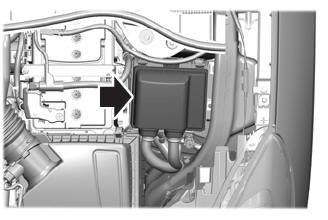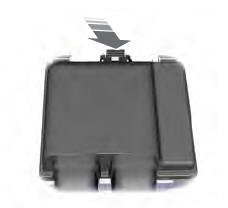Ford Escape: Body System - General Information / Description and Operation - Body - Overview
Insulation
.jpg) WARNING:
To prevent the risk of high-voltage shock, always follow
precisely all warnings and service instructions, including instructions
to depower the system. The high-voltage system utilizes approximately
300 volts DC, provided through high-voltage cables to its components and
modules. The high-voltage cables and wiring are identified by orange
harness tape or orange wire covering. All high-voltage components are
marked with high-voltage warning labels with a high-voltage symbol.
Failure to follow these instructions may result in serious personal
injury or death.
WARNING:
To prevent the risk of high-voltage shock, always follow
precisely all warnings and service instructions, including instructions
to depower the system. The high-voltage system utilizes approximately
300 volts DC, provided through high-voltage cables to its components and
modules. The high-voltage cables and wiring are identified by orange
harness tape or orange wire covering. All high-voltage components are
marked with high-voltage warning labels with a high-voltage symbol.
Failure to follow these instructions may result in serious personal
injury or death.
NOTICE: Electric vehicles contain High Voltage Traction Batteries (HVTB). Before cutting or welding near the High Voltage Traction Battery (HVTB), the High Voltage Traction Battery (HVTB) must be removed to avoid possible damage.
Refer to: Important Safety Instructions (100-00)
.
Refer to: High Voltage System Health and Safety Precautions - Overview (100-00 General Information, Description and Operation).
Refer to: Battery and Battery Charging Health and Safety Precautions (100-00 General Information, Description and Operation).
Refer to: Health and Safety Precautions (100-00 General Information, Description and Operation).
Insulation is used as a sound-deadener to reduce exterior road and powertrain noises from the interior of the vehicle. Mastic insulators are also used as insulation. Insulation is installed:
- under the roof.
- above and below the instrument panel.
- at the cowl side panels.
- over the front and rear floorpans.
- inside the B-, C- and D-pillar sections.
- on the wheelhouse/quarter panel.
- behind the rear quarter trim panel.
Other forms of insulation include:
- front tunnel stiffening pad.
- dash panel stiffener.
- rear wheelhouse mastic pads.
- rear door mastic pads.
It has heat-bonded mastic deadeners for improved NVH characteristics.
It also has sound dampeners located inside the D-pillar and plug holes in the inner rear quarter.
Body Sealer Types and Applications
Seam Sealer
- heavy-bodied, non-sag adhesive/sealer used on standing cosmetic seams, truck bed seams, tooled door skin seams and floorpans.
- can be used on water leaks and noise concerns.
Silicone Gasket and Sealant
- form-in-place gasket and multi-purpose adhesive/sealant.
- room temperature curing silicone rubber.
Silicone Spray Lubricant
- keeps the door and window weatherstrip pliable and soft.
- makes the door easier to close.
- retards weatherstrip squeaks.
- retards weatherstrip wear.
- helps retain door window alignment by reducing friction between the glass frame and the rubber weatherstrip.
- should not be used prior to painting.
Trim and Weatherstrip Adhesive
- quick drying, strong adhesive designed to hold weatherstripping onto all body panels and surrounding metal.
 Specifications
Specifications
M..
 Diagnosis and Testing - Body System
Diagnosis and Testing - Body System
Global Customer Symptom Code (GCSC) Chart
Diagnostics in this manual assume a certain skill level and knowledge of Ford-specific diagnostic practices...
Other information:
Ford Escape 2020-2025 Service Manual: Removal and Installation - Hydraulic Control Unit (HCU) - Vehicles With: Vacuum Brake Booster
Removal NOTE: Removal steps in this procedure may contain installation details. NOTE: A new HCU is equipped with an ABS module. A new ABS module does not come equipped with an HCU . NOTE: The PMI process must begin with the current ABS module installed...
Ford Escape 2020-2025 Service Manual: Diagnosis and Testing - High Voltage Battery, Mounting and Cables - Hybrid Electric Vehicle (HEV)
Diagnostic Trouble Code (DTC) Chart Diagnostics in this manual assume a certain skill level and knowledge of Ford-specific diagnostic practices. REFER to: Diagnostic Methods (100-00 General Information, Description and Operation). WARNING: To prevent the risk of high-voltage shock, always follow precisely all warnings and service instructions, including instructions to depower the..
Categories
- Manuals Home
- 4th Generation Ford Escape Owners Manual
- 4th Generation Ford Escape Service Manual
- General Procedures - Transmission Fluid Level Check
- Locating the Pre-Collision Assist Sensors
- Plug-In Hybrid Electric Vehicle Drive Modes
- New on site
- Most important about car
Under Hood Fuse Box
Locating the Under Hood Fuse Box

Accessing the Under Hood Fuse Box

